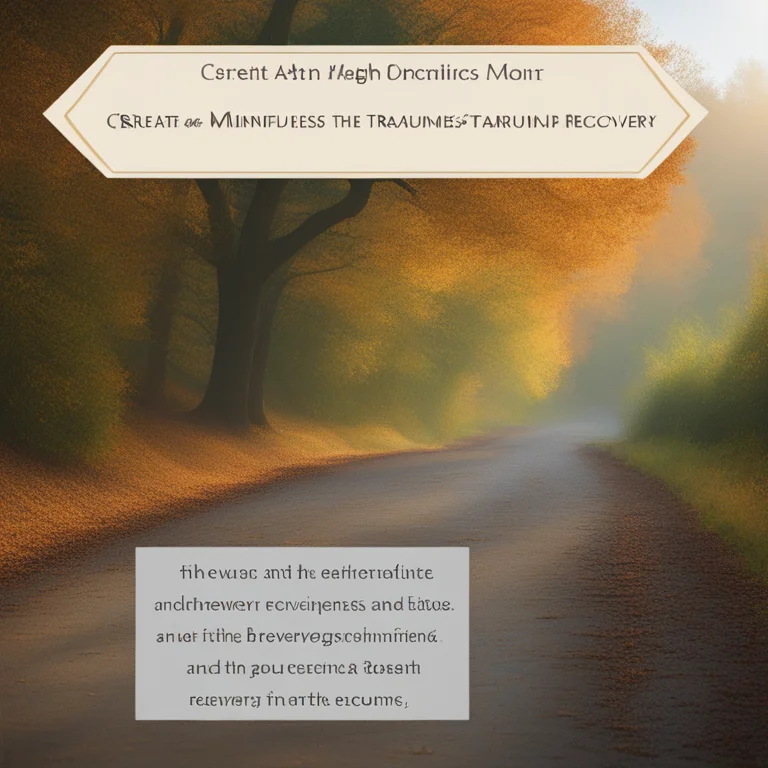
Healing with Mindfulness: Meditation's Role in Trauma Recovery
Discover the therapeutic potential of mindfulness meditation in addressing and managing the effects of trauma. Learn techniques to foster healing and resilience.
article by Hina Kurosawa
Introduction to Mindfulness and Trauma
Meditation has long been a stalwart in the pursuit of spiritual growth and emotional well-being. Today, mindfulness meditation especially holds a significant place in modern therapeutic practices, often being applied as a powerful tool in trauma recovery. The convergence of ancient wisdom and contemporary psychology has birthed a dynamic approach to healing that respects both the complexity of human trauma and the capacity for personal transformation. The intellectually rich and emotionally supportive landscape of mindfulness guides individuals through the aftereffects of traumatic experiences, providing a pathway towards resilience and peace.

The Mechanism of Mindfulness
Understanding the science behind mindfulness paints a clear picture of its efficacy. Engaging in mindfulness meditation activates areas of the brain associated with the regulation of emotions and the assessment of threats. When confronting trauma, these regions often become hypersensitized, leading to overwhelming psychological distress. Mindfulness creates a buffer, enhancing one's ability to manage anxiety and depressive symptoms—a ray of light to those lost in the shadows of their past. As the meditator brings nonjudgmental attention to the present moment, the turmoil within begins to subside, initiating the process of healing.

Meditation Practices for Trauma
A cornerstone of therapeutic meditation for trauma is learning to ground oneself in the now. Various techniques such as focused breathing, body scanning, and guided imagery serve as anchors, diverting the mind from past vulnerabilities and fears. Each practice offers a unique pathway: focused breathing regulates the autonomic nervous system; body scanning promotes body awareness and dissipates somatic tension; and guided imagery constructs a safe mental sanctuary. By alternating between these exercises, individuals can cultivate a bespoke mindfulness routine that best suits their journey towards healing.

Creating a Safe Space
Before diving into meditation, the importance of a safe environment cannot be overstated. For those with traumatic histories, physical and psychological safety are paramount for successful meditation practice. This might mean finding a quiet, comfortable space, establishing boundaries, or having a trusted guide facilitate the process. By ensuring that safety is a priority, individuals can more effectively surrender to the meditative experience, allowing the restorative properties of mindfulness to take effect without unforeseen triggers disrupting the process.

The Role of Routine in Recovery
Consistency is key to leveraging the benefits of mindfulness meditation in trauma therapy. A regular meditation routine encourages neural plasticity, promoting the development of new, healthier pathways in the brain. Over time, this restructuring fosters decreased reactivity to trauma-related stimuli and strengthens one's command over their emotional responses. Consequently, what begins as a structured practice of mindfulness may eventually substantiate into a habituated response, offering a refuge in moments of stress or anxiety.
Combining Modalities for Comprehensive Healing
Mindfulness should not stand alone in the healing process but rather be integrated with other therapeutic modalities. Combining mindfulness with cognitive-behavioral therapy (CBT), eye movement desensitization and reprocessing (EMDR), or somatic experiencing can create a well-rounded approach to trauma recovery. Each method brings its unique strengths to the table, addressing different facets of trauma, and it is through this integrative approach that individuals often find the most profound healing.
Embracing the Journey Ahead
Embarking on the path of mindfulness meditation for trauma is a testament to human resilience. It empowers individuals to reclaim control over their inner world and rewrite their personal narratives. As research delves deeper into potential applications and societal acceptance widens, the future of mindfulness in trauma therapy is poised to become even more promising. With professional guidance and a compassionate approach, the journey of self-discovery and healing may yield transformative results and help lay the foundation for a life reclaimed from trauma's gripping hold.
Published: 1/9/2024
Modified: 1/9/2024
More predictions
Come back here soon to learn more about yourself and your future


Boosting Memory with Meditation Techniques
Discover how mindfulness and meditation practices can enhance memory retention and cognitive function in our daily lives.


Eyes-Open Meditation: A Journey Within
Discover how meditating with eyes open offers a unique path to mindfulness, blending ancient wisdom with present-moment awareness.


Mind Boost: Can Meditation Enhance Intelligence?
This article delves into whether meditation practices can contribute to increased intelligence, combining scientific insights and practical advice for mental enhancement.